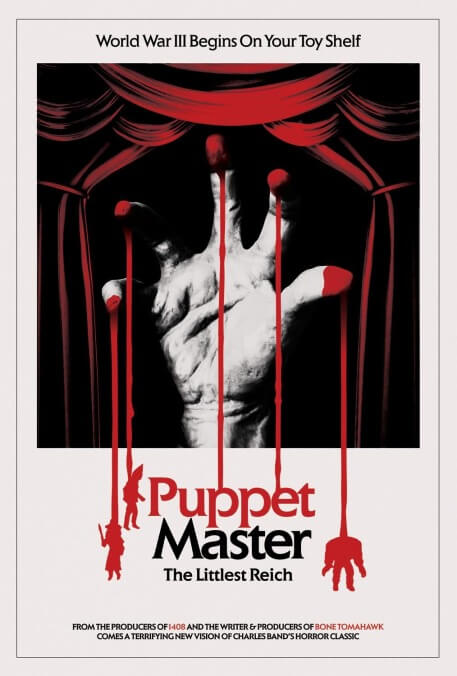Puppet Master reboot The Littlest Reich is a self-satisfied wallow in tastelessness

Say this, if nothing else, for the new Puppet Master: It delivers all the puppet-on-person mayhem a bloodthirsty midnight-movie audience could ever demand. In fact, for long stretches of its slender 90-minute running time, The Littlest Reich plays like nothing more or less than its own kills-only supercut, offering one scene after another of pint-sized assassins slaughtering the guests of a Texas hotel. Throats are slashed. Guts are spilled. Limbs are torn clean off. One poor schmuck ends up pissing on his own severed head, in a gross-out money shot for the ages. A few minutes later, a sleeping woman gets a surprise so nasty that you can scarcely believe the movie is really going there. It’s gnarly as hell.
Murderous marionettes aside, none of this Grand Guignol carnage much resembles a Puppet Master movie. The brainchild of Charles Band, whose Full Moon Features positioned him as the Roger Corman of the VHS era, the original Puppet Master and its nearly a dozen (!) sequels brought an almost touching ambition and eccentricity to the direct-to-video trash heap: They were cheapo killer-doll slashers that augmented their requisite sex and violence with dense comic book-style mythology and primitive but charmingly tactile effects. The Littlest Reich, which reboots rather than advances the story, lands a notch higher on the professionalism scale; the cast features a few actors you might actually recognize, which helps account for this being the first entry in the long-running series to open in theaters. But it’s also a more mean-spirited and tongue-in-cheek B-movie than its predecessors, closer in proudly “politically incorrect” spirit to something that East Coast grindhouse rival Troma might vomit out.
Improbably, the screenplay is by a major (and majorly slumming) talent: S. Craig Zahler, writer and director of Bone Tomahawk and Brawl In Cell Block 99. Not that you can often tell. While Zahler generally excels at prolonging and improving the setup that most genre flicks treat like a formality, the first act of The Littlest Reich really does feel like something you have to endure before the “good stuff” starts. After a 1989 prologue that establishes the ritualistic murders committed by disfigured German dollmaker Andre Toulon (Udo Kier, because who else?), the film jumps ahead to the present day, when collectors gather for the anniversary of the killings, hoping to buy, sell, and trade the culprit’s seemingly inanimate creations. A smarter film might have used this fan-con angle to satirize horror-nerd culture, but Zahler and the film’s directors, Sonny Laguna and Tommy Wiklund, won’t bite the hands that feed them. Their hero is a sad-sack, divorced comic book store clerk (a very checked-out Thomas Lennon) whose nascent romance with an accommodating dream girl (Jenny Pellicer) seems designed to flatter the fantasies of the target demographic.
Most of The Littlest Reich takes place on the eve of the convention, when the puppets spring to life and begin butchering their owners, in a series of over-the-top kill scenes, almost all staged inside the most affordable, obtainable of shooting locations: a hotel room. As it quickly becomes clear from their targets—a gay man, a Jewish couple, a Romani horndog—the puppets are (topicality alert!) total Nazis, picking up where Hitler left off. Dyed-in-the-wool fans might here note that the Toulon of the original series was a Holocaust survivor, not a perpetrator, and while it’d be silly to treat a shoestring direct-to-video horror franchise as a sacred text, the change does seem counterproductive. “I can think of six million reasons why,” Edgar’s wiseass Jewish boss (Nelson Franklin) answers when asked why he’s choosing to fight instead of hide. The moment might be more cathartic if The Littlest Reich weren’t otherwise encouraging us to hoot and holler at the genocidal bloodshed—to get off on the massacre, even after it’s revealed to be a final solution in literal and figurative miniature.
The Littlest Reich, in other words, aims to shock. Its sensibility falls somewhere between Fangoria, the movie mag that produced the film, and the edge lord provocations of a particularly trollish subreddit. Horror buffs should appreciate the nods, from a score by Lucio Fulci’s regular composer, Fabio Frizzi, to the appearance of Re-Animator alum Barbara Crampton as the cop who killed Toulon and now leads tediously expository tours of his mansion. And the gore, to be clear, really is something: an impressive, elaborate, practically achieved smorgasbord of spraying arteries, loosed entrails, and tiny hands bursting through rubber flesh. Yet in their cruder, much less self-aware way, the early Puppet Master movies had more charm. Their titular terrors, for one thing, possessed real personality—a sense of life that The Littlest Reich, inventive though it can be in the dismemberment department, can’t match. It’s all guts, no glory, and a little too self-satisfied with its own “transgressive” mean streak to be much fun.